The color of goats depends mostly on the breed. Most breeds have a few colors that are the most common. A few breeds are relatively colorful, but these are rarer than breeds with a set color.
If you’re looking for a goat that is a specific color, your best bet is to find a breed that is usually that color. White, black, and similar colors are the most common, though there are some breeds with unique markings.
We’ll look at many of the popular goat colors and markings below. These don’t appear in every breed of goat, though. Again, it depends mostly on the breed.
The 22 Goat Colors, Markings & Patterns
1. Black

This color ranges from a very dark, “midnight” black to a reddish-black that almost looks brown. This is a rarer color among goat breeds, as most only have a small percentage that is black. However, there are some fully-black goat breeds, especially among Cashmere goats. Cashmere goats are sheared for their fiber. It can be challenging to get a white or brown fiber dyed into a black fiber, so the black goats are sometimes sought after since they’re already black.
While this color isn’t super standard, most breeds come in a black color, at least some of the time. Even some breeds that are almost entirely white will sometimes be black. It isn’t challenging to find a breed that may produce a black goat. However, finding a black goat from that breed can be difficult.
2. Brown

Goats come in all shades of brown, from chocolate to dark brown. Medium and lighter browns are also possible. However, if it is an extremely light brown, it probably falls under the color brown roan, which we will discuss shortly. Brown colorations aren’t all that rare, but they are rarer than white-colored goats.
Again, it depends mostly on the breed. Nigerian Dwarfs come in all sorts of brown colors, for instance. However, these colors are rarer than the other colors the breed comes in. There are very few, mostly brown breeds. Usually, the brown colors will be dotted in a herd here and there, not make up the bulk of it.
3. Gold

Gold describes anything that is a tannish color. It can be used to describe cream colorations, as well as reddish-tan colors. It’s anything brownish that is between a brown roan and a white. Like with most solid colors, most breeds that come in brown can also come in gold. It isn’t uncommon among all the goat breeds, though some will exhibit their gold coloration more than others.
You might also see colors described as dark gold and red gold. Usually, exactly what counts are regular gold or reddish-gold will vary from show to show. Almost all golds have some red in them since that’s what separates them from the whites. However, how much red counts as red gold varies.
4. White

White is probably the quintessential goat color. When most people imagine a goat, they imagine a white one. This is large because most goat breeds not only can be white, but they are mostly white. Most other colors are sprinkled in a nearly-white herd. Of course, some breeds are whiter than others. However, most goat breeds are over 50% white, and it isn’t uncommon to see a herd that is over 90% white.
There are a few genetic ways a goat can become white. Sometimes, genetically, the goat may be gold but appears as a white. Other times, the breed may have an actual white gene that is dominant among the population.
If you’re looking for a white goat, you aren’t going to have any trouble at all.
5. Belted or Branded
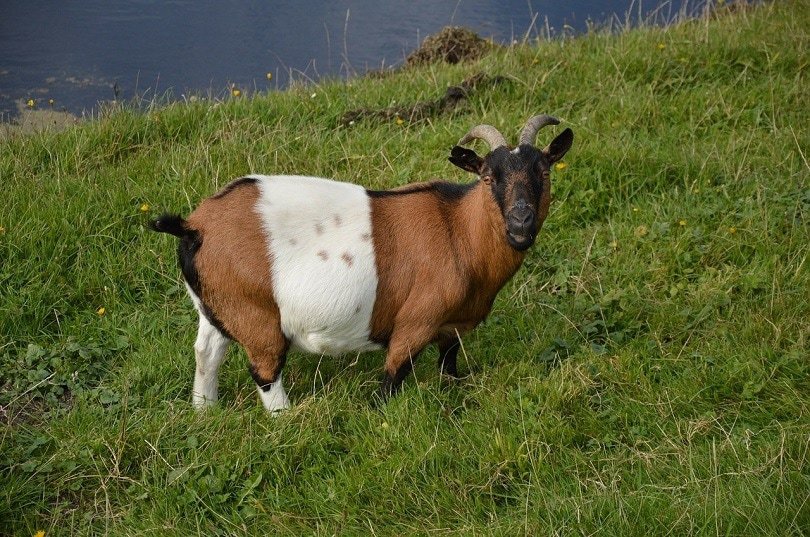
This is a relatively common marking involving a full or partial white band stretching around the middle of the goat. It looks like a belt. These markings can be thin or wide. Sometimes, there might be other markings inside the band, such as spots. The band can also be broken so that it doesn’t stretch all the way around.
This marking is also common with other markings. It doesn’t take up the whole goat or override other markings, so it isn’t common to see a very marked up goat with this pattern.
6. Black and Tan
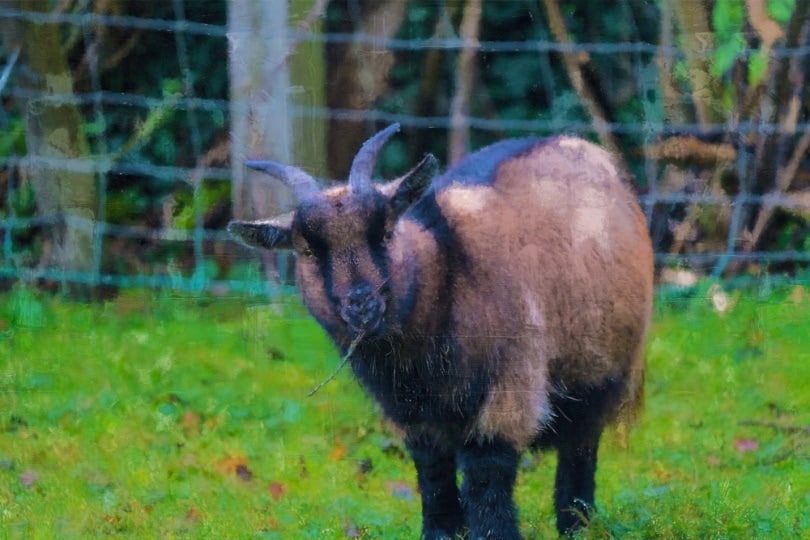
Black and tan goats are mostly black. However, they have tan facial stripes and socks. The black can be any shade, from a dark black to a reddish black. The socks usually don’t go over the knees. Some tan may appear on the tail and similar spots around the body, but it is usually minimal. The ears are commonly tan or at least have some tan on them.
In goat breeds that can become black, this coloration may be relatively more common. It won’t appear in breeds that can’t be black, for apparent reasons.
7. Buckskin
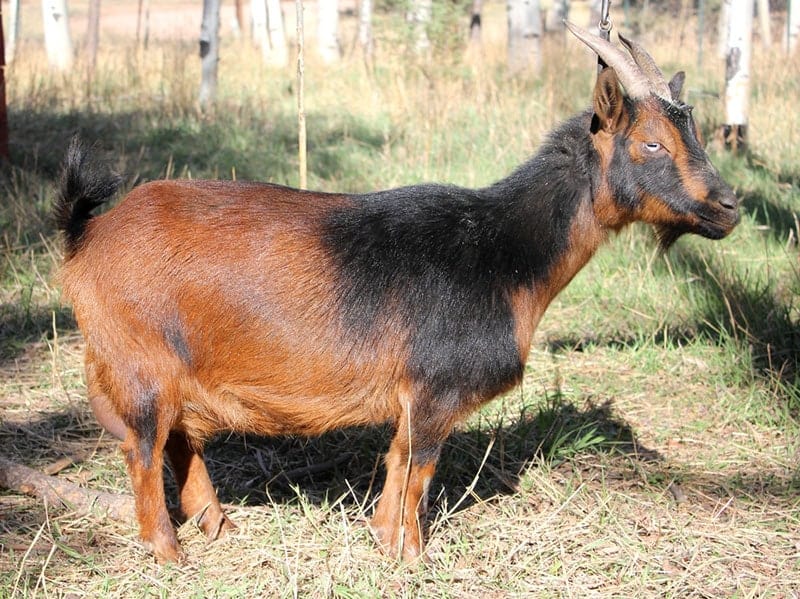
Buckskin goats have one color on their cape, legs, face, dorsal stripe, and tail. However, they have a different color everywhere else. Usually, the cape and face are the darker color, while the rump and legs are the lighter color. However, this can vary quite substantially. Sometimes, it’s the other way around, and this is not necessarily a defect.
This pattern can be broken with white or other markings. It isn’t uncommon to see a buckskin goat with a belt or similar marking.
8. Chamoisee
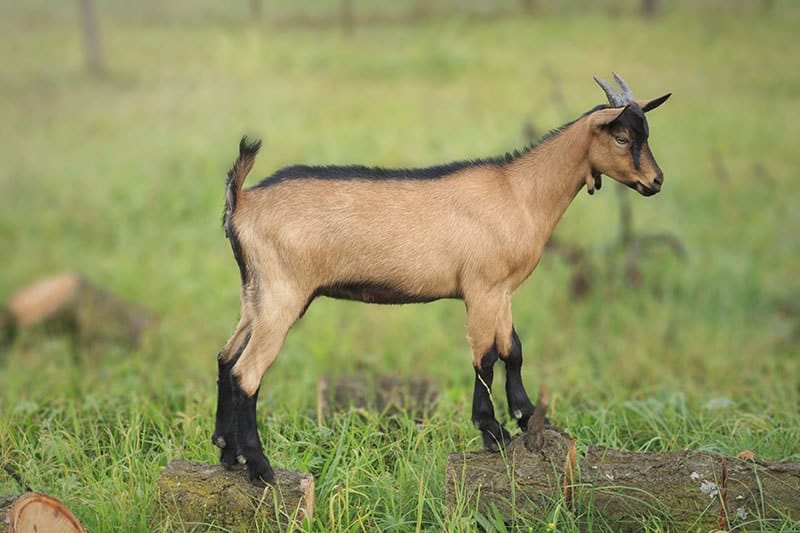
This is both a color and a pattern. The body of the goat is a light bay to dark mahogany. In other words, it’s a shade of brown or tan that doesn’t have much red in it. The goat also has a black or nearly-black dorsal stripe, belly, and legs. It may appear to be the opposite of the buckskin. However, there is no cap. The colors usually don’t fade together but are very apparently different.
White markings and other patterns can interrupt this marking, though they usually don’t in any significant way. This coloration is rarer than some of the solid colors, but it still isn’t odd to see a goat with it. Of course, it’s only possible in some breeds, like the Nigerian Dwarf.
9. Schwartzal

This goat is mostly white. However, the head is a darker color. Usually, it is black but brown and any other darker color are also possible. The darker color may also be on the legs, either as socks or just larger spots. Sometimes, the goat’s whole body is lightly sprinkled with the darker color, especially around the neck and shoulder area.
Schwartzal can also be overlaid on other patterns. It can be difficult to figure out exactly what patterns you’re dealing with in these cases since it can blend in on other patterns like the buckskin.
10. Roan
Goats with a roan pattern are any color but with thick sprinkles of white hairs. These sprinkles are pretty obvious and tend to bunch up, though they don’t exactly create spots. This pattern can be overlaid with any other pattern. Usually, the goat will exhibit another pattern and have a lot of white hair. Sometimes, it can be difficult to distinguish this pattern if the goat has many other patterns.
11. Pinto
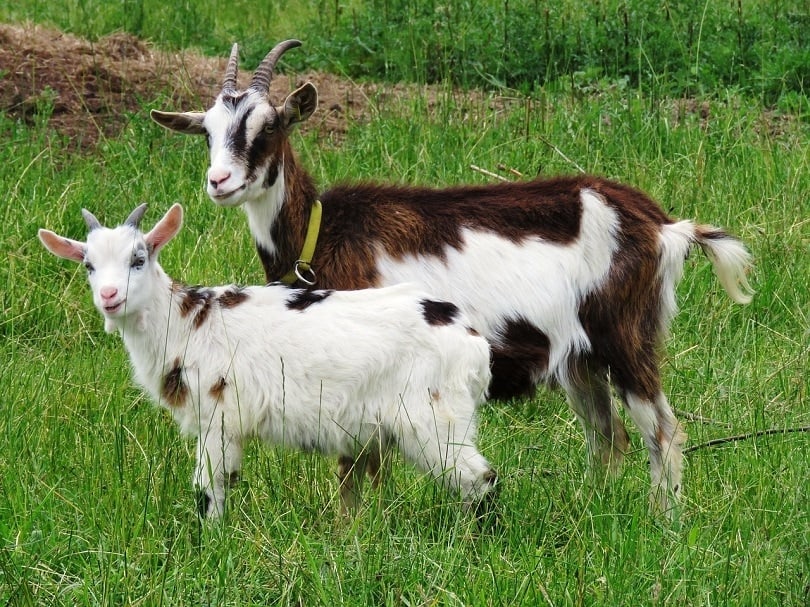
Pinto goats have any color but white as their primary coat color. Then, they have irregular white patches throughout. The white patches may be big or small. They are not spots since they aren’t entirely round. This pattern is common with nearly all darker colors, including everything from black to tan. Sometimes, the white may incircle the darker pattern, leading to darker spots in the white sections.
There aren’t many rules for this pattern. Randomness prevails.
12. Random Markings
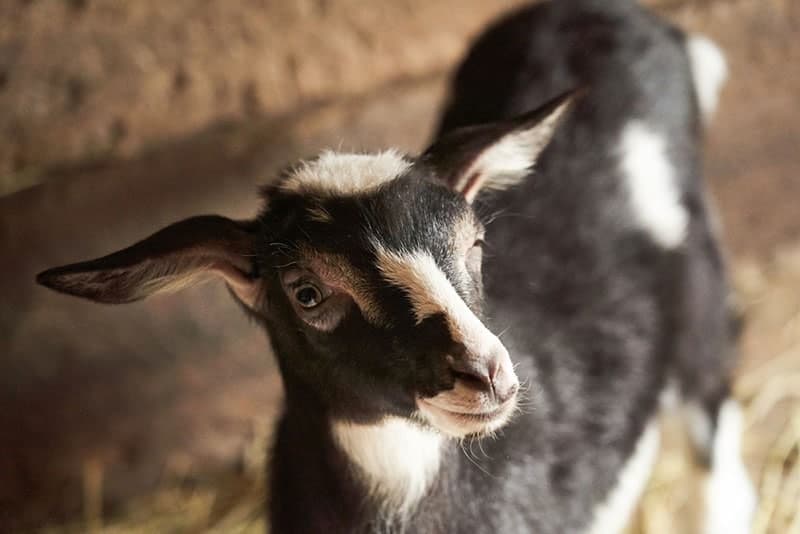
Not all possible markings have names. Instead, there are a lot of unnamed, random patterns in many goat breeds. These are usually the combination of some darker color and white. They may be spots or unregular splotches. Sometimes, a goat is two-toned, with a considerable portion being a darker color and an equally large portion being white. It isn’t uncommon for the white patches to be spotted with the darker color.
Three-colored goats are common, but they are usually rarer. It wouldn’t be surprising to find a goat that is white, brown, and black, though.
13. Moon Spots
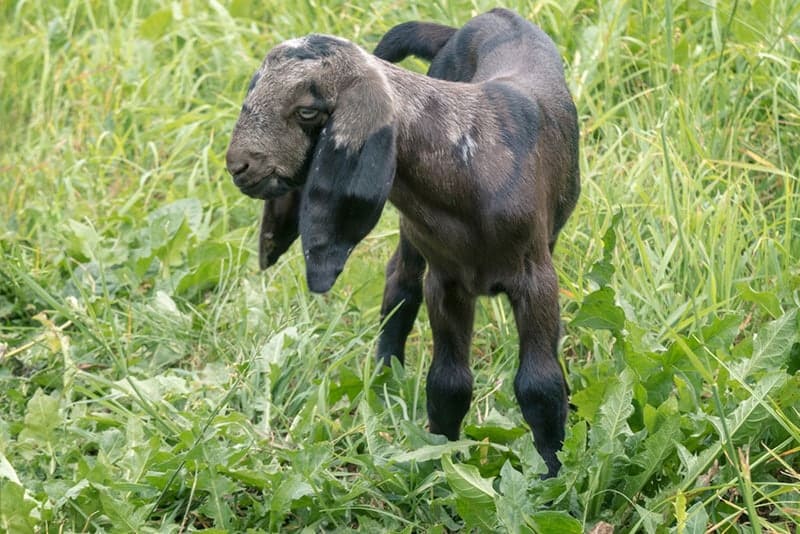
The term “moon spots” is sometimes used to describe random spots of any color over a coat of any other color. They’re called “moon spots” because they resemble the spots on the moon—completely random. These spots are usually smaller and may be paired with other random markings. Usually, the spots are white, but they can be any color technically.
14. Dorsal Stripe

A dorsal stripe is a stripe that runs down the goat’s backbone. It is a part of many patterns and can be paired with just about any other pattern. The stripe can be any color, as can the majority color of the goat.
15. Facial Stripe
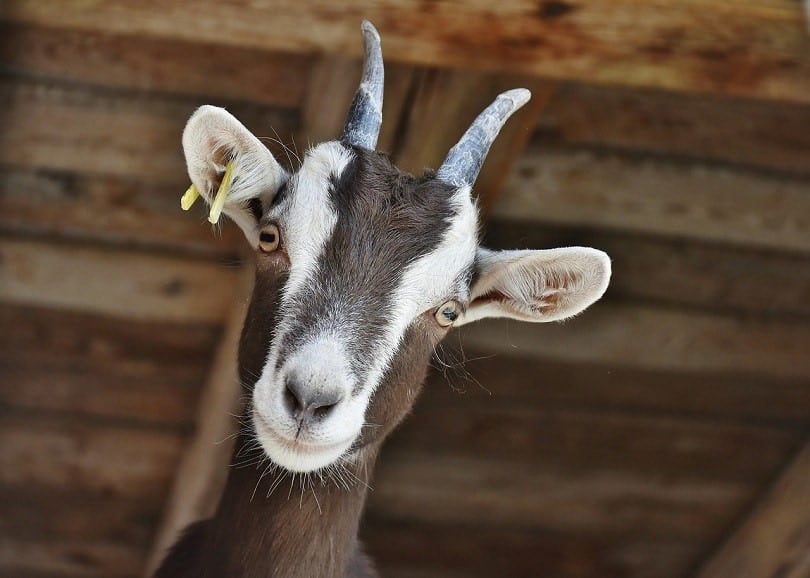
Facial stripes are any stripes that are on the face. Usually, these stripes are part of a buckskin pattern. However, they can appear by themselves or when the rest of the buckskin pattern gets covered up with other patterns and markings.
Usually, facial stripes are darker in color and run from the eyes to the same point on either side of the nose. But other markings can overlay this pattern and off-set its regularity.
16. Frosted Ears and Nose

This marking involves lots of white hairs around the ears or nose. This makes the goat appear lighter in those areas. In other words, they appear “frosted”. This pattern can occur with any others and may be darker or lighter.
17. Cou Blanc

The phrase “cou blanc” means “white neck” in French. As the name suggests, this sort of pattern involves the goat having a white neck and usually a white cape. The rest of the goat is a darker color.
While the phrase makes this pattern seem quite regular, it isn’t. Sometimes, the white may extend over the majority of the goat’s back, with the rump only holding the darker color. Sometimes, it hardly extends past the neck. It depends.
Other patterns and markings can extend over this color.
18. Cou Clair
Cou clair is also called a peacock pattern. It is the same as the cou blanc pattern, except the white is some other, lighter color. It may be tan, cream, or any other off-white shade. Because it isn’t white, the pattern doesn’t count as a cou blanc. However, these patterns are similar in almost every other way.
19. Cou Noir
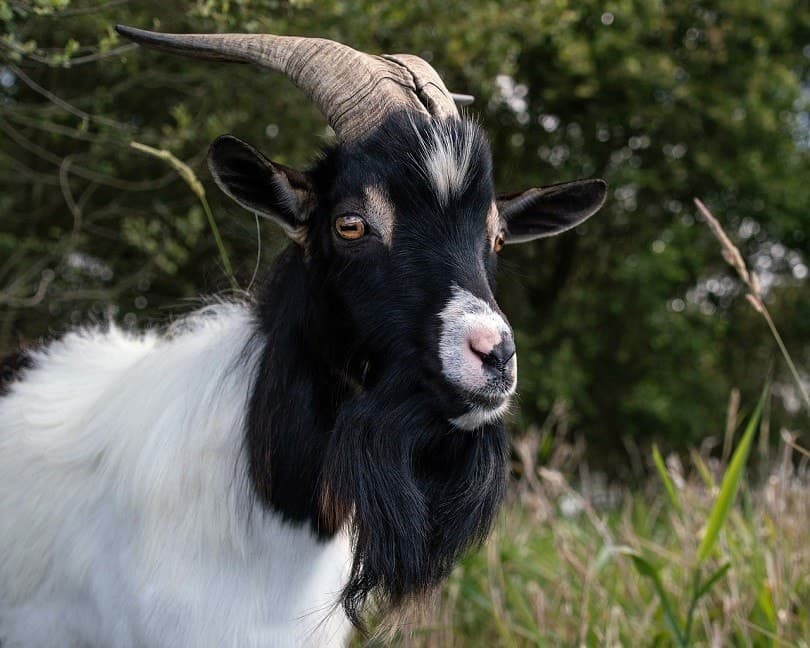
This phrase means “black neck” and is the opposite of the cou blanc. The upper body and neck are a black color, while the goat’s lower end is white. This is a rarer pattern in some breeds, though it is relatively common in some. In mini goats, it seems to be particularly rare.
Otherwise, this is pattern is exactly like the previous two, only with different colors.
20. Splashed White

This pattern involves random white patches on a goat that is mostly a different color. It isn’t uncommon for the goat’s primary color to appear inside the white spot. The white area can be minimal, or it can take up half the goat. Other colors can also overlay this pattern, or the splashed white can become part of a bigger pattern.
21. White Pole Spot

This is a spot that is right on top of the goat’s head. It may be part of a larger splash pattern, or the goat may have any number of other markings. The spot itself is called a pole spot if it lands right on the top of the goat’s head.
22. White Blaze
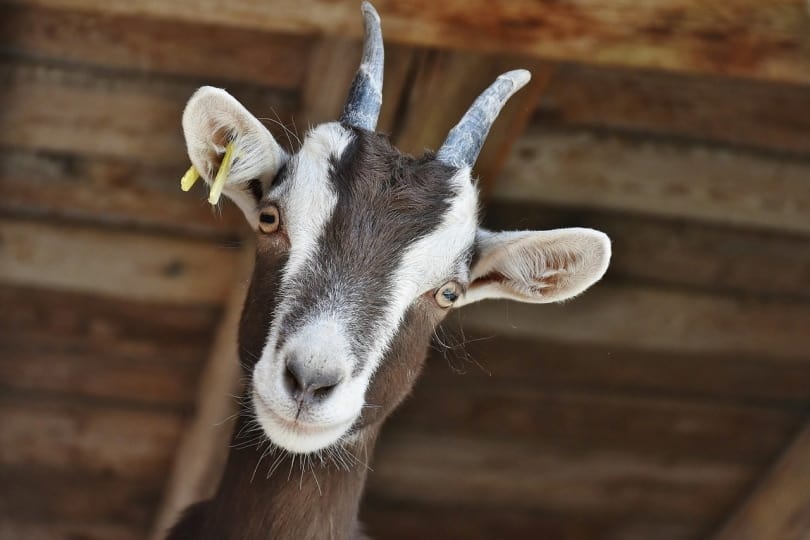
A white blaze is a white stripe or another marking on the center of the goat’s face. The goat may have other white markings or none at all. This marking can be paired with any of the others on this list.
Featured image credit: AnimalPro, Pixabay
